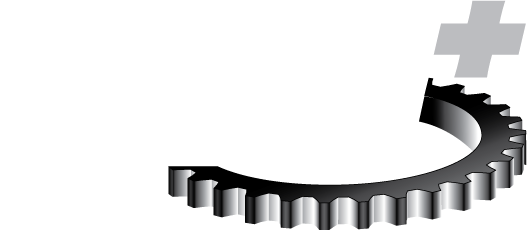
19 May KBE+, Inc. Partners with Gear Motions to form Kinatech
KBE+, Inc. has partnered with Gear Motions (https://gearmotions.com/) to form a Joint Venture named Kinatech, LLC (https://kinatech.com/). Kinatech, which stands for Kinematic Technology, represents an entirely new and unique way of stopping and holding motion through a simple geartrain. The uniqueness is in the application of common gear forms to provide true ‘non-back-driveability’ without the use of friction or impulse loading such as is common with latching systems.
It truly is a new non-back-drivable rotating gear system finally solves the challenge of locking a gear drive without having to apply friction or engage a latching mechanism. The patented Kinatech technology, co-developed by inventors Stephen and Nick Kochan, gear manufacturer Gear Motion, and engineering consulting firm KBE+, utilizes a unique configuration of common gear forms that provide fully self-actuating locking.
In the Kinatech design, all applied loads during both the gear drive mode and locking mode are carried directly by the gears in mesh. This allows the torque load to be held in place without employing electricity, pneumatic, hydraulic, friction, or other external braking mechanisms. Kinatech can be driven or locked in both directions and is not susceptible to the vibrations that cause rotational slip like worm and wheel systems. But perhaps the most revolutionary aspect of this simple yet elegant mechanical system is that it truly will not back-drive. Additionally, the standard analysis methods (AGMA, DIN, ISO, etc.) can be used to accurately predict capacity, service life, and efficiency, important engineering attributes when considering a new technology.
To provide further perspective on the shortcomings of traditional gear-locking approaches, KBE+ President Mark McVea who co-developed the Kinatech technology, explains, “Until now there have been basically two ways to stop motion: friction and mechanical latching. Friction methods rely on component interfaces that dissipate relative motion as heat through surface wear, and then when the two components stop moving the friction holds them assuming the surface has not been damaged during the energy dissipation phase and the clamping force is sufficient. But friction devices (e.g. friction clutches, worm and wheel gear systems, etc.) are prone to slippage and eventual failure as the friction surface wears or their properties change from things like excessive heat, dirt and oil. Another common method of holding two rotating components together is a positive latch that engages one of the rotating components. The problem here is that latch engagement can place tremendous shock loading on the latch, causing it to break or prematurely wear down the mating surfaces. There is a third locking technology known as worm & wheel gearing. While generally thought of as a non-back-drivable technology, worm & wheel really can be back-driven but consumes massive energy to do so. In a statically loaded back-drive mode worm and wheel gear systems are typically about 5% efficiency, which is unacceptable particularly if there is a requirement for complete locking of one component to another. If there is vibration present, a worm and wheel back-drive inefficiency increases significantly, making it even more likely to slip”.
“Now let’s look at Kinatech. Here we have created a non-back-drivable system that provides a rotary path for torque to flow in the positive drive direction and at the same time incorporate a mechanism to fully lock the applied torque load. It uses the geartrain that carries the torque load in drive as the brake mechanism, thus its non-back-drivable load limit is the same as the power capacity of the geartrain. The patented Kinatech technology uses the kinematic relationship of the driving geartrain to also lock the main power-path gears. As such, the two components attached to those gears move and lock without any friction interface to wear or change over time and without any ‘latch’ component that can fail in shock loading.”
In total, Kinatech’s ground-breaking technology provides five key benefits according to its inventors and co-developers. First is the simplicity of using the kinematic relationship of the driving gear train to lock the two gears in place and support incredible amounts of torque. Second is the scalability realized through its unique arrangement of gears which can accommodate any application from precision instrument components to industrial-sized operations. It can also be manufactured from different materials such as aluminum, cast iron or even plastic. Third is the increased reliability resulting from a small number of parts and short load path. Fourth is the greater affordability from Kinatech’s use of only a few components, making it much easier to manufacture and assemble than traditional gears and brakes. Finally, the flexibility derived from its unique configuration that allows it to fit in virtually any gearbox envelope.
For more information on how this revolutionary new technology works and the benefits it can provide your rotary application, contact Mark McVea, CTO of Kinatech, LLC (markmcvea@kinatech.com) or call us at: 315.569.5237.

Sorry, the comment form is closed at this time.